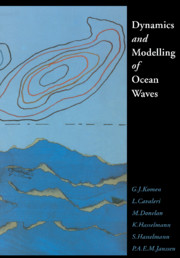Book contents
- Frontmatter
- Contents
- Contributors
- Preface
- Chapter I Basics
- Chapter II The physical description of wave evolution
- Chapter III Numerical modelling of wave evolution
- Chapter IV Applications to wave hindcasting and forecasting
- Chapter V Global satellite wave measurements
- Chapter VI Wave data assimilation and inverse modelling
- Chapter VII Summary and outlook
- Members of the WAM group
- Affiliations and addresses of contributors
- Notation and abbreviations
- References
- Index
Chapter VI - Wave data assimilation and inverse modelling
Published online by Cambridge University Press: 22 January 2010
- Frontmatter
- Contents
- Contributors
- Preface
- Chapter I Basics
- Chapter II The physical description of wave evolution
- Chapter III Numerical modelling of wave evolution
- Chapter IV Applications to wave hindcasting and forecasting
- Chapter V Global satellite wave measurements
- Chapter VI Wave data assimilation and inverse modelling
- Chapter VII Summary and outlook
- Members of the WAM group
- Affiliations and addresses of contributors
- Notation and abbreviations
- References
- Index
Summary
General features of wave data assimilation and inverse modelling
Background
In previous chapters we have discussed the use of a mathematical model, the third generation wave prediction model, to compute the state of the sea. We can distinguish between hindcasts, nowcasts and forecasts, the difference being the time for which the sea state is computed relative to the clock time. A forecast field can be computed only by a model. However, the model estimation of hindcast and nowcast fields can be improved using observations, which have been considered in the previous chapters of this book only for validation of the underlying physics or for verification of model results. This combination of using model results and observations to create an optimal estimate of the sea state is called data assimilation or analysis. The word analysis originates in early meteorological applications, for which meteorologists would subjectively draw isobaric patterns on the basis of isolated pressure observations. They analysed the weather. Later, this work was carried out with numerical models.
Observed data can also be used to validate and improve models. When the model improvement is carried out using numerical automatic model fitting techniques, one speaks of inverse modelling: instead of using a given model to compute data, which are then compared with observations, the observations are used in an inverse mode to construct an optimally fitted model.
Information
- Type
- Chapter
- Information
- Dynamics and Modelling of Ocean Waves , pp. 403 - 480Publisher: Cambridge University PressPrint publication year: 1994
